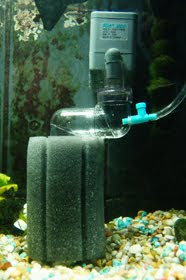DIY CO2 Reactor, Diffuser; Using Sponge Pre-Filter & Pump

Updated 12-27-18
Another use for a Sponge Filter, whether a standard Sponge Filters or a Sponge Pre-Filter (such as the Filter Max #2 pictured here) is as a diffuser/reactor for CO2 systems.
This DIY CO2 Reactor/diffuser works better than just about any other according to my friends in the industry who are expert planted aquarium maintenance pros. It is similar to the gravel vacuum with a sponge plug method popularized in a planted aquarium forum in that this method utilizes a top-notch sponge filter material for better CO2 absorption then slow dispersion. As well the Filter Max Sponge Filters have a secure cap that does not blow off under pressure from the water pump, unlike the other method.
This method is an excellent choice for use with the simple Gelatin, DIY Yeast methods as well as the more advanced "ISTA Co2 Refillable Aluminum Cylinder Set", and even professional regulated CO2 canisters
 (1) As per the picture to the left, connect a relatively slow pump such as the Rio 200 Pump (138gph) to what would normally be the pump pick up, but in this case, the flow is directed downward so as to trap the CO2.
(1) As per the picture to the left, connect a relatively slow pump such as the Rio 200 Pump (138gph) to what would normally be the pump pick up, but in this case, the flow is directed downward so as to trap the CO2.(2) Then drill a small hole so as to add an air line control valve (such as found in the Lees Valve Set #14104)which then goes to the source of the CO2.
From this valve run airline tubing to your CO2 source.
Use the valve to regulate CO2, but the water pump at least in part keeps the CO2 contained until it is absorbed through the sponge material.
 (3) Add an in-line air check valve as close to valve as possible to prevent water back up into the airline tubing once the CO2 is exhausted. I often find that it is best to still "blow out" the airline (by mouth) prior to adding to fresh CO2 each day.
(3) Add an in-line air check valve as close to valve as possible to prevent water back up into the airline tubing once the CO2 is exhausted. I often find that it is best to still "blow out" the airline (by mouth) prior to adding to fresh CO2 each day.And simple, you're done!
ADVERTISEMENT:
In controlled tests using s Sponge Filter as compared to a Ceramic air stone or standard reactor/diffusion bell, the Sponge Filter achieved much higher dissolved CO2 levels when calculated with KH and pH tests
 The use of a homemade pressurized bottle can be used for Jungle Fizz Tabs or DIY yeast CO2 generators.
The use of a homemade pressurized bottle can be used for Jungle Fizz Tabs or DIY yeast CO2 generators.*For further planted freshwater aquarium information:
Aquarium Plants; General Care, Beginner to Advanced
*Another tip to secure filter intakes, tubing, etc. are the ZooMed Mag Clips. Although their primary use has been for aquarium heaters, I have adapted these for lift tubes, air line and much more.
Further Reading:
*Aquarium Lighting, Facts & Information for Planted Aquariums
*NilocG Liquid Plant Ferts | NPK, Thrive, Enhance
*Aquarium Chemistry
Labels: Diffuser, DIY CO2 Reactor, Filter Max, Sponge Filter, Sponge Pre Filter



 POND SPONGE FILTERS
POND SPONGE FILTERS FILTER MAX SPONGE PRE-FILTER
FILTER MAX SPONGE PRE-FILTER Rio Internal Filter
Rio Internal Filter EVERYTHING AQUATIC
EVERYTHING AQUATIC
0 Comments:
Post a Comment
<< Home